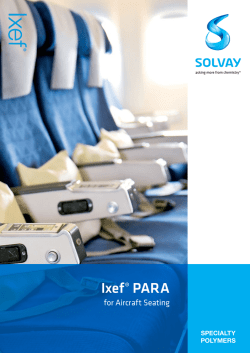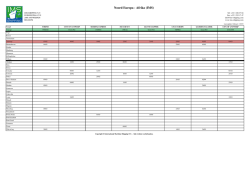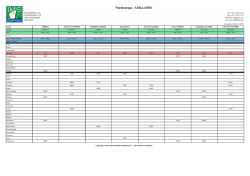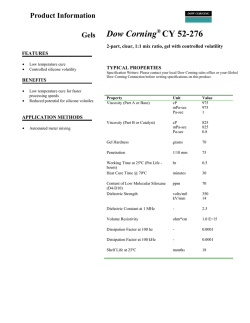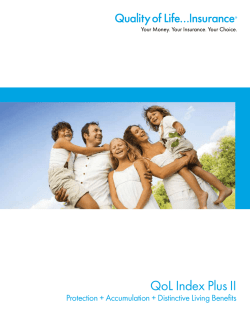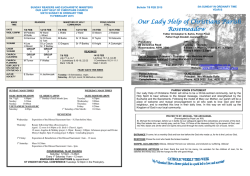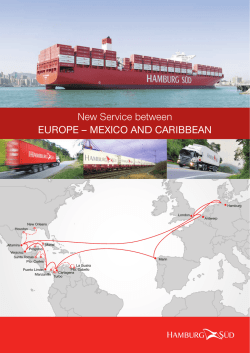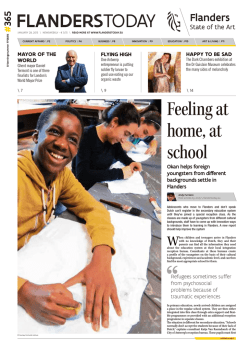
5th E4Water Newsletter
Issue 5 – January 2015 E C O N O M I C A L LY A N D E C O L O G I C A L LY E F F I C I E N T WAT E R M A N A G E M E N T I N T H E E U R O P E A N C H E M I C A L I N D U S T R Y EDITORIAL Please feel invited to visit our website (www.e4water.eu), which gives further details on the E4Water project and on upcoming events related to Industrial Water Management. Welcome to the 5th E4Water Newsletter, where we would like to inform you about current activities in the project. There’s news for the E4Water Solvic Case Study in Antwerp (Belgium): Solvay SA, Belgium is one of three companies that took home European Responsible Care Awards during a special ceremony at the Cefic annual general assembly in Paris on October 17th. In the Environment category Solvay SA were honoured for their work done in the E4Water project together with Evides and Vito by “Saving water through symbiosis” and “Looking at the bigger picture”. Your E4Water Team E 4 W AT E R N E W S L E T T E R C O N T E N T S : At the Solvic site in Antwerp the third pilot was successfully started. The so-called “Mobile Kit”, a transportable minielectrolysis unit, aims to demonstrate the possibility to recycle the salty effluents of a neighboring industry partner into a manufacturing loop at Solvic. Further read more about recent news, have a closer look into the work of E4Water and get informed about partners Evides (Netherlands) and Cefic (Belgium) and their specific work in E4Water. 2014 European Responsible Care Environment Award 2 Solvay Lillo E4WATER – “MOBILE KIT” 4 Evides Industriewater, reliable water partner for the industry 5 Cefic is the forum and the voice of the chemical industry in Europe 7 E4Water project present at the EIP Water conference exhibition 8 Announcement of upcoming events 8 At the Solvin site in Martotell (Spain): the E4Water consortium visits the Solvin demonstration pilot that aims to close the water loop in the PVC production. www.e4water.eu 1 Issue 5 – January 2015 2014 European Responsible Care Environment Award Solvay Lillo E4WATER circular economy in water management “Saving water through symbiosis” receives European honors If Europe’s chemical industry – a sector with enormous growth Since 2012, Solvay has taken part in “demonstration projects” within Europe’s ambitious “E4Water” initiative, which aims to bring significant water saving approaches up to industrial scale. The Solvay Lillo plant (Solvic in the Harbour of Antwerp, Belgium) has partnered with industrial neighbors to develop a “circular economy” where residual water is passed on from partner to partner to be re-used. Solvay Lillo and other companies use large amounts of drinking water in this sea harbour area Not only has the approach been successful, it is a recipient of the 2014 European Responsible Care Awards, sponsored by the European Chemical Industry Council. umes (30 % at the minimum, and even possibly up to 60 % if additional conditions are fulfilled) of potable water intake, and come close to zero salt waste and zero liquid discharge,” explains Sabine Thabert, Environmental Coordinator & Water Conservation Manager, Solvay Lillo. For Solvic, savings will amount to 30 % (half a million m3 per year) at least, or even 60 % of current drinking water consumption. In addition, less effluent water will be released to the environment. Solvic, in Lillo, has been working to demonstrate new water savings by closing loops between industrial partners in the area of the Port of Antwerp (Belgium). After taking inventory of all potentially recyclable water flows, the partners selected water streams that would be the most suitable for recycling, and as well installed additional treatment modules where needed. This water “circular economy” therefore makes best use of residual water, which in turn reduces Solvay’s intake of potable water (water safe enough to be consumed by humans). Savings, savings and more savings The project consists in three modules. The first unit involves recycling through ultrafiltration and reverse osmosis membranes to produce demineralized water that can be used in Solvic’s chemical processes. The second unit can produce this demineralized water from brackish surface water, pumped up from the docks of the Antwerp harbor near the plant. This 2 first demo modules are now operational, with a capacity of delivering 33 m³ high quality water every hour by recycling effluent waters. This has the potential to save 290,000 m³ drinking water/year. The 3rd and ultimate level is to demonstrate the possibility to recycle the salty effluents of a neighboring industry partner into a Solvay manufacturing loop. The 3rd module involves an innovative manufac- “The aim of this project is to ultimately deploy, in a step-wise approach, a water management concept that will save large vol- www.e4water.eu 2 Issue 5 – January 2015 turing testing unit (brine pre-treatment + micro-electrolysis unit, developed in Rosignano, Italy). “We are confident that we can recycle salty waters from the industrial partner into our own manufacturing process. This way, the external partner avoids effluent production and it will bring to Solvic an additional 20m³/h water savings (170 000m³/year) and a strong reduction of virgin salt consumption, worth 10 ton per hour savings,” says Sabine Thabert Besides saving water, the project serves as an “Industrial experimental garden”. It will help inspire other water reuse in the chemical sector, via similar symbiotic cooperations. This experiment involves besides different Solvay sites (Lilo, Brussels, Italy (URE Rosignano )also the E4-Water partners Evides Industriewater and VITO (*) and Solvic’s neighbors of the Antwerp chemical cluster. It demonstrates the value of collaborating to maximize water savings. All 19 partners of E4water (research, chemical companies, water companies, …)will have access to technical data about the project, which will also be more widely communicated by the EU Commission (“dissemination”) by mid 2016 via the FP7 platform. The E4-Water project in Lillo is in line with Solvay’s general policy on water management. “One of the Group’s 12 key 2020 sustainability targets is to achieve viable water management in each of the sites located in regions under hydric stress,” says Solvay’s HSE Director Patrick Cleret. Words of the Responsible Care Award jury: “Water is a key issue for the chemical sector and the Solvay entry is a very good, up-to date project which offers another fine example of industrial ecology.“ A.Hanneuse (Plantmanager Solvic) and S.Thabert (Environmental coordinator Solvic) receiving the Responsible Care Environmant from J-P Clamadieu (Cefic President and CEO, Solvay) during the Award Ceremony About the European Responsible Care Awards Since 2005, the European Responsible Care Awards, sponsored by CEFIC, highlight the chemical industry’s ongoing achievements throughout Europe. Awards are presented in three categories: Energy Efficiency, Environment – for which Solvay was selected – and Product Stewardship. The Award Ceremony was held in Paris, 17 October during the European Chemical Industry Global Convention. www.e4water.eu 3 Issue 5 – January 2015 Solvay Lillo E4WATER – “MOBILE KIT” One of the targets in the Solvay Lillo (Solvic) E4Water project is to demonstrate the possibility to recycle the salty effluents of a neighboring industry partner into a Solvic’s manufacturing loop. Therefore the third module in the so called demo “industrial garden for symbiotic water savings” was foreseen. Together with Solvay URE - Rosignano, Italy an innovative manufacturing testing unit was developed. In this testing unit the effects of the recovery of diluted brines and/or wastewater on the performances of an industrial electrolysis plant can be studied. treated to be reused in electrolysis and could be adapted to the characteristics of different plants. • Small scale on-situ chlorine production with dimensions close to an industrial one, so that treated volumes are replicable in an industrial context. The “THE MOBILE KIT” is a real research facility, meaning that process parameters are constantly monitored and brine is frequently analyzed. This constitutes a major contribution to the building of know-how in the field of recycling of all aqueous effluents generated by chemical production processes. The so called “MOBILE KIT” is a transportable mini-electrolysis unit, built in two containers that can be easily moved from one production site to another. It was a challenge to design and to install all chemical and physical equipment necessary for the recycling process, in easily transportable containers. The “MOBILE KIT” project addresses the need, for Solvay (and not only) electrolysis plants, to be more and more environmentally compatible. With this aim, the project specifically deals with recycling of aqueous effluents generated by chemical production processes containing NaCl, trying to achieve a zero-effluent concept and savings in raw materials The “MOBILE KIT” could be considered like a process simulator allowing testing and experimenting directly in industrial plants, recreating the same conditions of membrane electrolysis, without interfering in the production process itself. This unit performs: On 8 July 2014 the first load of salty water from Solvic’s neighbor in the Antwerp Harbor Cluster was fed to the “MOBILE KIT”. • Process parameters evaluation (brine quality, membranes,..) revealing if effluents can be reused or how they should be Solvic site in Antwerp (Belgium): The Solvay team infront of the 3rd E4Water demonstration pilot at site, the so-called “Mobile Kit”. www.e4water.eu 4 Issue 5 – January 2015 Evides Industriewater, reliable water partner for the industry Evides Industriewater (EIW) has it’s headquarter in Rotterdam. EIW is a subsidiary of Evides NV which is also the holding company of Evides Drinkingwater (EDW). EDW delivers drinking water in the south west of the Netherlands (see figure) but EIW has a broader supply area with also plants in other parts of the Netherlands, Belgium and Germany. The key business of EIW can be divided in process water supply, waste water treatment and water reuse. Some figures: 52 Mm3/y process water supply, 36 Mm3/y demineralised water, 100 Mm3/y waste water treatment and 12 mobile RO units with 900 m3/h capacity. EIW has a lot of major industrial companies as clients like Dow Chemical, BASF, Shell, Exxon Mobile etc. These are often located in big industrial parks like the Rotterdam, Antwerp, Vlissingen and Hamburg. (2010). Local surface water is used as feed water source. The treatment consists of pre-treatment with DAFF (Dissolved Air Flotation Filtration), softening (IX), VRO (vertical air sparged RO), RO and mixed bed IX to achieve a high quality demi water. Due to the combination of the applied techniques, (bio-) fouling of the RO is not a problem anymore and this is achieved without the use of biocides or frequent chemical cleanings. Innovative solutions EIW is always looking for innovative solutions to optimise treatment processes. An example is the demi water plant Botlek Supply areas of the Evides Drinking water Demin water plant Botlek with vertical air sparged RO EIW and E4WATER EIW is involved in two E4Water case studies, one at the Dow site in Terneuzen and one at the Solvic site in Antwerp. Dow chemical in Terneuzen is the major customer of EIW. Location: Terneuzen Sources: treated waste water, condensate, surfacewater Products: Proces water: 300 m3/uur Coolingwater: max 650 m3/uur Deminwater: max 750 m3/uur Polished water:max 1.050 m3/uur Techniques: SF, MMF, MBR, IX, RO Dow site Terneuzen Key data current water supply to Dow Terneuzen www.e4water.eu 5 Issue 5 – January 2015 Case study 1 near Dow site: Mild desalination (“Biox”) and locally stored run off rain water (“Spuikom”). These water sources are first pre-treated and then desalinated. At this moment the pre-treatment consists of coagulation, lamella separation and ultrafiltration. For the (partial) desalination two techniques are used: nanofiltration and electro dialysis reversal. In the first quarter of 2015 this pilot set up will be investigated and a final set up will be chosen. Already different water sources and product water qualities are supplied to Dow. One of the goals of Dow Terneuzen is to reduce the water source which is also used for the drinking water production and replace it with local available (brackish) water sources. The following three water sources are selected: cooling tower blow down water, tertiary waste water from Dow CS1 (Dow Case): Pilot set up Case study 2 at Solvic site: demi water production out of waste water and dock water feed channels), coagulation with PAC, ultrafiltration (Inge multibore) and reverse osmosis (Hydranautics). At the Solvic site, EIW has designed and is operating 2 demo unit to produce demi water of high quality. The first unit has waste water (85% cooling tower blow down water) and phreatic ground water as a feed sources. The demo unit consists of a disk filter (to remove particles which can clog the ultrafiltration The second demo uses dock water (from the harbour) as feed water which is pre-treated with sand filters and fed to the demo unit which has the following techniques: Amiad strainer (protection of UF), ultrafiltration (Pentair Seaguard) and a double pass reverse osmosis step (Dow Filmtec membranes). CS2 (Solvic Case): Demo unit 2 with Dokwater as feed water www.e4water.eu 6 Issue 5 – January 2015 Cefic is the forum and the voice of the chemical industry in Europe Cefic is a trade association based in Brussels and committed partner to EU policymakers, facilitating dialogue with industry and sharing our broad-based expertise, since 1959. Cefic also advises and provides services to our industry, including the entire value chain of customers, retailers and transporters. of industry best practices on sustainable water management among its members and other sectors. (e.g., paper sector, refinery sector). We keep an open dialogue with water providers and several representatives from water stewardship approaches and tools. Cefic represents 29,000 large, medium and small chemical companies in Europe, which directly provide 1.2 million jobs and account for 20% of world chemical production. Cefic’s contribution to E4Water Cefic is one of the partners contributing to the E4Water project, a 7th framework programme funded by the EU Commission. Our main role in the project is to identify the regulatory barriers and bottlenecks to the industrial scale-up of pilot projects. Examples of such barriers include, water saving measures that prevent companies from meeting emission limit values, as set in their industry permit, over-stringent requirements for the reuse of waste water for agricultural or other purposes, and difficulties in implementing waste and REACH regulation requirements for recycled substances from waste water streams. Once these gaps and barriers have been identified, Cefic will draft solution recommendations to be discussed with policy makers. One possible avenue could be to formulate recommendations for integrating the outputs of the project in the Industrial Emissions Directive (IED – 2010/75/EC) through the mechanisms of the BREF (Best Available Technique Reference) documents. As an active member of the International Council of Chemical Associations (ICCA), which represents chemical manufacturers and producers all over the world, Cefic seeks to strengthen existing cooperation with global organisations such as the United Nations Environment Programme and the Organisation for Economic Co-operation and Development (OECD) to improve chemicals management worldwide. Cefic’s commitment to water innovation: partnerships and projects The chemical industry is working vigorously to boost innovation in water and related topics that can help improve the use and treatment of water and further develop a sustainable water policy. To achieve these objectives the chemical industry is working in partnership with other sectors, as well as in dedicated projects addressing sustainable use of water management (Cefic flagship initiative on water) and water innovation (E4Water). Cefic also contributes to disseminating activities of the project through our involvement in workshops and events such as the EIP on Water annual conference and other conferences gathering innovation partners in Europe, such as the International Chemical Exhibition and within THINK TANKS activities in Brussels. In June 2015, we plan to host a joint workshop between E4Water and the Cefic flagship initiative to address economic incentives that promote the uptake of water innovations. Here, E4Water partner, IVL (Institutet för vatten- och luftvårdsforskning) Swedish Environmental Research Institute’s will present preliminary results related to life cycle assessments undertaken by the project. Cefic is also working with partners, through the European Technology Platform for Sustainable Chemistry (SusChem) and the European Water Platform (WssTP), to bring recognition to the importance of water and to have it considered as a valuable raw material rather than a utility. Concretely, both the water and chemical sectors have joined forces to support the development of the European Innovation Partnership (EIP) on Water. The EIP on Water is an EU Commission-driven initiative which helps to pool expertise and resources on water innovation, technological and non-technological, by bringing together public and private actors at EU, national and regional level, combining supply- and demand-side measures. The Cefic flagship initiative on water aims to support companies in their sustainable water management strategies. The flagship has two main objectives: 1) to disseminate sustainable water management practices of companies through Cefic’s Responsible Care network and 2) to provide a forum for companies to exchange best practices by organizing webinars and workshops. An important milestone achieved through this flagship initiative is the agreement on how to define “sustainable water management” for the chemical sector. As a result, a questionnaire has been developed for companies to undertake self-assessments of their water management system, at single chemical operational site. This questionnaire is currently being tested by companies who volunteered for the pilot exercise, which will be finalized in the first quarter of 2015. Cefic is also fostering the exchange To learn more about our activities, please visit the Cefic Water Flagship initiative website and our dedicated water website. For further information, please contact: Ann Dierckx – HSE Manager [email protected] Antonia Morales Perez – Innovation Manager [email protected] Giovanna Zamburlini – Environmental Policy Counsellor [email protected]. www.e4water.eu 7 Issue 5 – January 2015 E4Water project present at the EIP Water conference exhibition ANNOUNCEMENT OF UPCOMING EVENTS Where you can meet E4Water The annual conference of the European Innovation Partnership (EIP) on Water took place in Barcelona (Spain) on 5 and 6 November 2014. Over 400 participants from all walks of life attended this second edition of the conference. Delegates from the European countries as well as other regions of the world had the opportunity to follow the presentations and visit the exhibition area. The E4Water project drew a lot of interest among the visitors to the exhibition. Visitors to our stand had a lot of questions about the overall focus of the project and the expected impact. They also showed especial appreciation for all the technical reports published by the project. 30 May – 3 June 2015 IFAT – Resource, Innovations, Solutions Munic, Germany 27 September – 1 October 2015 ECCE 10 – 10th European Congress of Chemical Engineering Nice, France Since the section of the website on upcoming events is regularly updated we invite you to visit our website for most recent changes. In general, the exhibition has been evaluated very positively by the conference attendants, update on innovative projects and Action Groups provided excellent topics for discussions and networking. Disclaimer We have received a letter “of appreciation from Ms. Wenning, Director of Quality of life, Water and Air for our contribution to the success of the Exhibition area of the EIP Water conference. The E4Water project has received funding from the European Union’s Seventh Programme for research, technological development and demonstration under grant agreement No 280756. The content of this newsletter cannot be considered as the European commission’s official position and neither the European Commission nor any person acting on behalf of the European Commission is responsible for the use which might be made of it; its content is the sole responsibility of the E4Water project partners. Although the E4Water consortium endeavors to deliver high quality, no guarantee can be given regarding the correctness and completeness of the content of this newsletter due to its general informational character. The E4Water consortium is not responsible and may not be held accountable for any loss suffered as a result of reliance upon the content of this newsletter. CONTACT Dr. Thomas Track / Dr. Renata Körfer / Dr. Christina Jungfer DECHEMA e.V. Theodor-Heuss-Allee 25 60486 Frankfurt am Main Germany FP7-NMP-2011.3.4-1 – Start Day: May 1st 2012 – Duration: 48 months This project has received funding from the European Union’s Seventh Programme for research, technological development and Phone: +49 (0)69 7564 -427/-619/-364 Fax: +49 (0)69 7564 -117 E-Mail: [email protected] [email protected] [email protected] demonstration under grant agreement No 280756. Disclaimer notice: The European Commission is neither responsible nor liable for any written content in this newsletter. www.e4water.eu 8
© Copyright 2025
